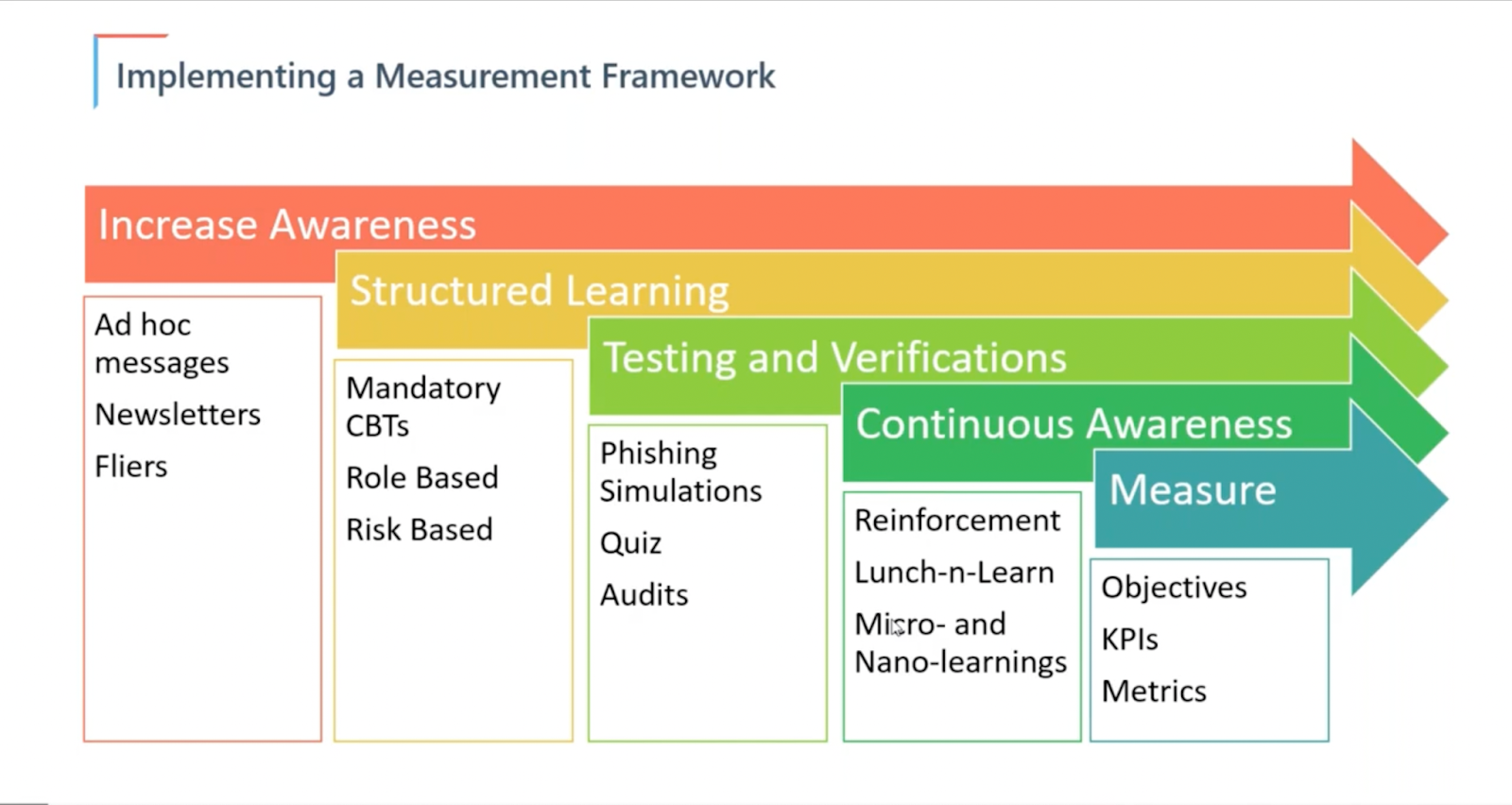
A cyber security awareness program involves all parts of a company and needs support from every level of management. Clear strategic goals are essential to guide the program and keep it focused on its objectives.
In a webinar hosted by Terranova Security’s CISO Theo Zafirakos, 42% of the attendees revealed that they don’t have any strategic goals set. While a program can still be launched without concrete goals, it will inevitably lack direction and thus encounter employee engagement issues.
Asking the question, "Why are you deploying a security awareness program?" is an excellent way to clarify your strategic goals.
Although the answer might not be straightforward, it is a crucial step, as establishing strategic goals clarifies your direction and helps you identify which metrics and KPIs to monitor.
Let’s review the three goal categories in a cyber security awareness program, provide examples, and discuss their importance.
Why security awareness program goals are important
Strategic goals identify what you aim to achieve and provide a collaborative framework for your team to follow. Without this type of guidance, your cyber security program can be a nebulous and challenging subject, making the early stages unorganized.
Goals must be identified so you can lay out a plan with all the required steps to get there. From here, you can identify key metrics and the appropriate curriculum necessary to support the accomplishment of the cyber security awareness training campaign.
Additionally, executive support is indispensable to promote adoption and engagement. If employees see the company leaders and their direct managers involved and participating in the cyber security training, they’ll be far more enticed to take the program seriously.
With clearly defined goals, it is much easier for executives to support your security awareness training initiative and develop it as a company-wide initiative.
Goal categories
To be useful, your strategic goals must be concrete, tangible, and in line with organizational priorities. They must also be easy to grasp and broad enough to allow you to convert them into KPIs, metrics, and activities that will contribute to their accomplishment.
In the case of cyber security awareness programs, your strategic goals should be broken down into the following categories:
Risks and behaviors
Modern cyber threats often rely on human errors and rapid evolution to evade the measures taken by organizations to thwart them.
While reducing the risk potential is a valid goal, it should be paired with behavior modification to ensure users don’t repeat unsafe actions as cyber threats adapt.
Security mindset
The best way to ensure that your workforce takes cyber security awareness seriously is to integrate it directly into your work culture. If managers become cyber security ambassadors, training on this subject becomes second nature, and employees understand the magnitude of the program.
Compliance obligations
Almost every industry has cyber security compliance obligations as the business world becomes digital. Whether legal or contractual, these obligations can have dramatic business impacts if they are not fulfilled.
Examples of strategic goals and how to track them
It’s a good idea to have one or more goals for each category to ensure your program covers all bases in regard to cyber security within your organization. Here are a few examples of the categories outlined above:
Diminish enterprise risks from cyber security threats through knowledge
This goal is achieved by empowering and motivating employees to improve their cyber security behaviors and actions. Most employees see phishing and other cyber threats as potential ways for them to get in trouble or even get fired.
By shifting the mindset from reactive to proactive, you can help your employees understand the importance of cyber security while providing them with the tools and knowledge to integrate it into their daily lives.
How to track this goal:
Track your progress on this goal by reporting on the deployment of your program activities:
- Does the organization conduct training sessions to educate employees on cyber risks and the importance of security in their daily work?
- Does the program have leadership commitment?
- Does your program consider the key risks and threats, and what are they?
- Do you have a defined plan that includes training, simulations, and reinforcement activities?
- What is the frequency?
- What is the duration?
- What is the deployment schedule, and did management follow it?
- Does the organization have acceptable use policies and procedures, and are they communicated to employees?
- Does the organization have an ambassador program to help promote awareness activities?
- Does the organization perform regular assessments of the program's effectiveness and adapt and optimize based on performance?
Enable employees to make safe cyber security decisions daily
This example can be especially powerful because it focuses on equipping employees with the proper knowledge to act confidently when faced with a potential cyber security issue. This goal can only be accomplished by creating a cyber-aware culture and providing a helpful framework for employees.
With this goal, your workforce will understand that the cyber security training they must undergo isn’t a chore but an opportunity to acquire valuable skills to help them work safely and more efficiently.
How to track this goal:
This goal can be tracked by collecting data on employee knowledge, behaviors, attitudes, and actions through:
- Knowledge questionnaires: An anonymous quiz can be sent to your target audience to determine current knowledge. The results can be used to select and prioritize topics, determine knowledge retention, and identify high-risk areas.
- Feedback surveys: An anonymous survey may be sent to a specific audience to solicit feedback on program content. The results can be used to determine whether your program is reaching its audience, whether it is relevant, and whether there are opportunities for improvement.
- Phishing simulations: Phishing simulations can be a practical learning activity and an evaluation exercise. They can be used to determine which behaviors, users, or departments may require prioritization. An initial simulation can also be used to establish a baseline before training deployment. Results can be used to track risky behaviors over time, such as clicking, sharing passwords, or opening file attachments. In addition, they can be used to track positive actions, such as reporting suspicious messages.
- Interviews: Discussions with department leads on various aspects of awareness programs (e.g., their objectives, concerns, past problems, capacity to participate). Preparing questions, selecting participants, and coordinating meetings will be necessary.
- System monitoring: Auditing data from other systems and processes can also provide valuable data on user behavior. Such systems can include firewalls, internet proxies, email gateways, and other user behavior analytics. Processes such as service desk tickets for cyber incidents are also suitable for tracking the adoption of secure practices.
Minimize corporate liability, risks, and costs arising from non-compliance
Depending on the industry your organization operates in, this goal could be the most important and impactful one to implement. Compliance can also be an internal inducement to bolster your own cyber security goals.
How to track this goal:
This goal can be tracked in conjunction with example 1 above:
- Does the program include activities related to applicable external industry obligations such as privacy, health, energy, finance, etc.? If so, what are they?
- Personal data protection requirements
- Cyber threats that can target sensitive information in each sector
- Handling personal data according to established procedures
- Contractual obligations
- Industry-specific standards
- What is the frequency of training on these topics?
- What is the percentage of participation?
- Have employees understood the requirements well, and how does the organization keep track?
- Training sessions
- Q&A sessions
- Dedicated contact for inquiries
- For the public sector, are there any specific government requirements?
Optimizing your program
Well-defined goals also provide an amazing opportunity to tweak and optimize your program as it is rolled out. These goals become goalposts for assessing success that can easily be modified or readjusted along the way.
The slide below explains how to support a strategic goal during a cyber security awareness training campaign.

Strategic Goals as a Path to Success
Strategic goals are an essential structure for a cyber security awareness training program and a guiding force throughout the campaign’s lifecycle. As you introduce new activities and metrics, it’s a good idea to ask yourself how these new initiatives support the overarching goal to evaluate whether they are adequate.
Watch this webinar to gain insights into strategic goals, metrics, KPIs, and other essential aspects of a successful cyber security awareness training program.